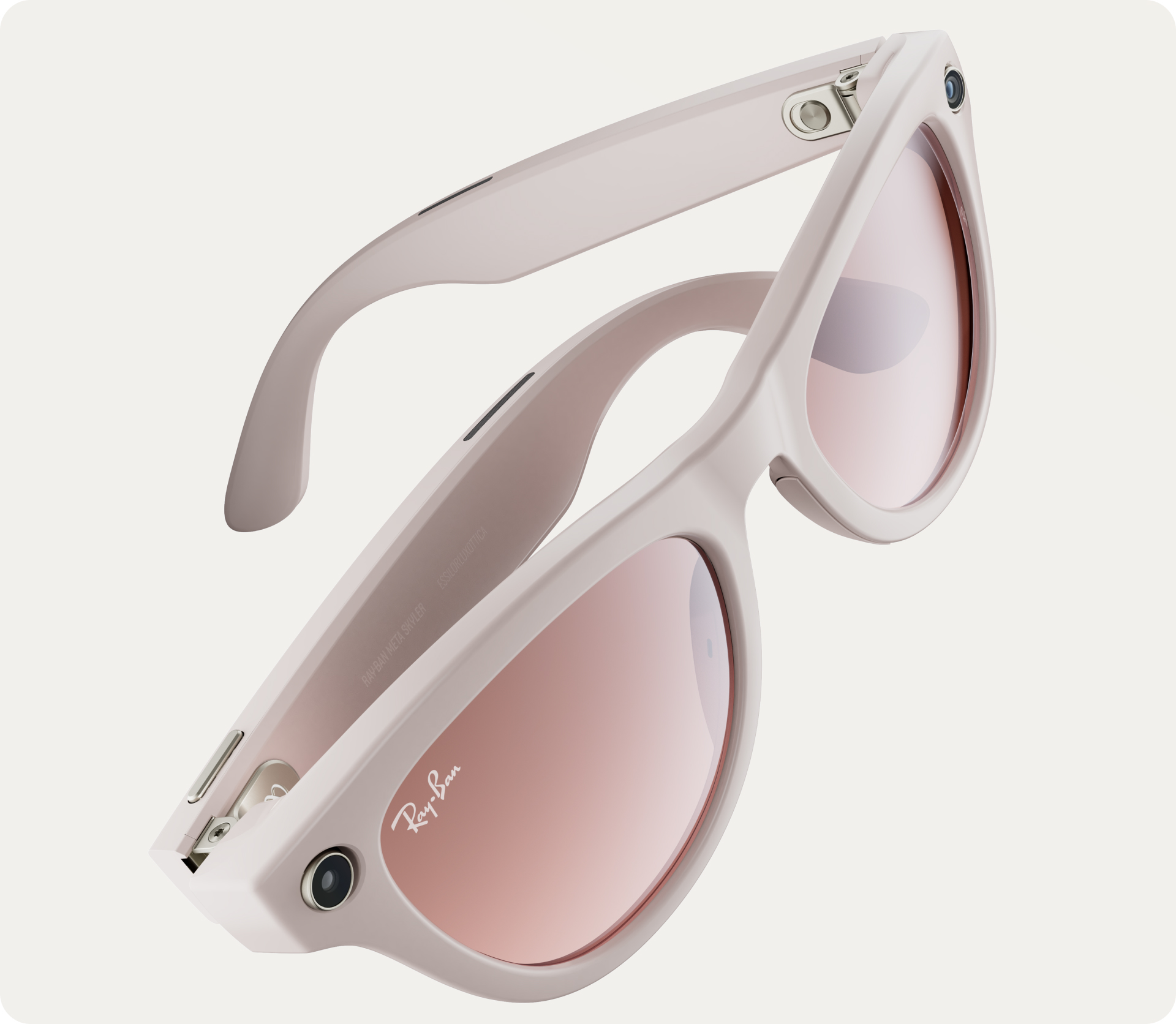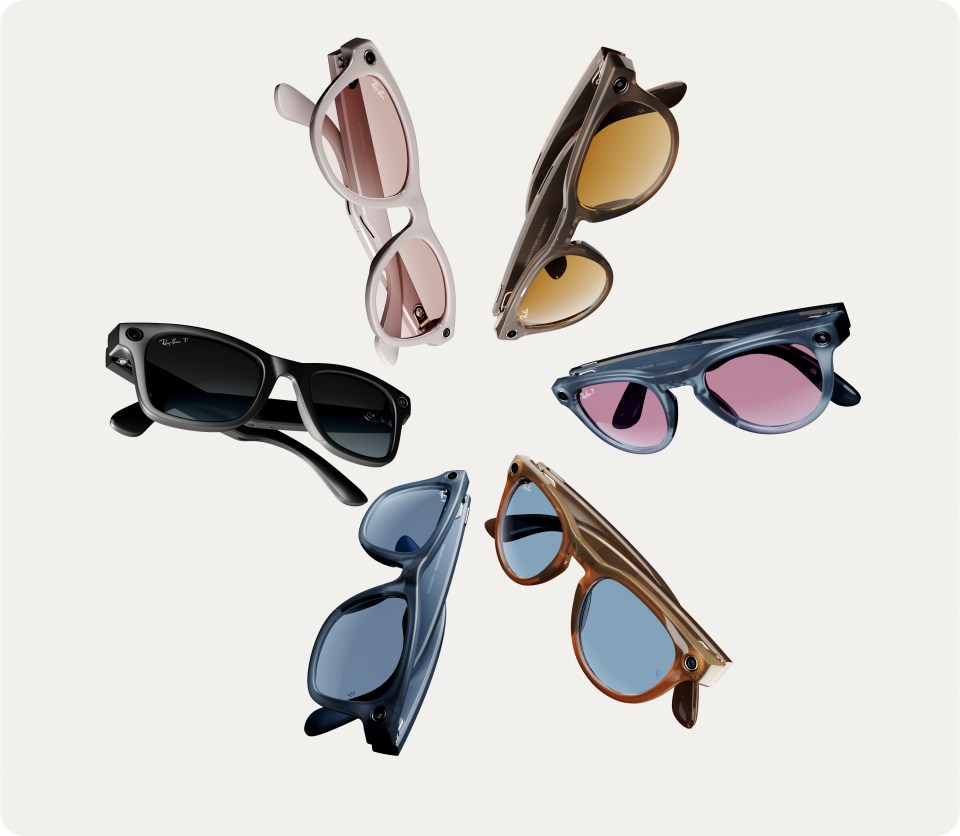
0:00 / 0:00
Még 2019-ben a Orion csapat fontos bemutatót készített a Meta alapítója és vezérigazgatója, Mark Zuckerberg számára, bemutatva a lehetséges hullámvezetőket a kiterjesztett valóság szemüveg-a döntő pillanat, amikor a papíron lévő elméleti számítások életre keltek. És ez a bemutató mindent megváltoztatott.
"Az üveg alapú hullámvezetőkkel és több lemezzel ellátott szemüveg viselése olyan érzés volt, mintha egy diszkóban lennénk" - emlékszik vissza Pasqual Rivera optikus. "Mindenhol szivárványok voltak, és ez annyira elvonta a figyelmedet, hogy még csak nem is az AR-tartalmat nézted. Aztán felvetted a szemüveget a szilícium-karbid hullámvezetők, és olyan volt, mintha a szimfónián hallgatnánk egy csendes, klasszikus darabot. Tényleg odafigyelhettünk arra, hogy teljes mértékben átéljük azt, amit építünk. Ez teljesen megváltoztatta a játékot."
Bármennyire is egyértelműnek tűnik ma a szilícium-karbid mint szubsztrát választása, amikor először indultunk el a az AR szemüveghez vezető út egy évtizeddel ezelőtt, minden volt, csak nem az.

"A szilícium-karbid általában erősen nitrogénnel dúsított" - mondja Rivera. "Zöld színű, és ha elég vastag lesz, akkor feketének tűnik. Kizárt, hogy optikai lencsét lehetne belőle készíteni. Ez egy elektronikus anyag. Nem véletlenül ilyen a színe, mégpedig az elektronikus tulajdonságai miatt."
"A szilícium-karbid már régóta ismert anyag" - ért egyet Giuseppe Calafiore, az AR Waveguides műszaki vezetője. "Fő alkalmazási területe a nagy teljesítményű elektronika. Vegyük az elektromos járműveket: Minden elektromos járműnek szüksége van egy chipre - de ennek a chipnek nagyon nagy teljesítményre is képesnek kell lennie, mozgatnia kell a kerekeket, és meg kell hajtania ezt a dolgot. Kiderült, hogy a hagyományos szilícium hordozóval, amelyből a számítógépekben és az elektronikában használt chipek készülnek, ez nem lehetséges. Olyan platformra van szükséged, amely lehetővé teszi a nagy áramerősséget és a nagy teljesítményt, és ez az anyag a szilícium-karbid."
Amíg a megújuló energiaforrásokkal kapcsolatos viták nemrégiben fel nem pezsdültek, az ilyen nagy teljesítményű chipkészletek piaca meg sem közelítette a fogyasztói elektronikai chipek piacának méretét. A szilícium-karbid mindig is drága volt, és nem volt nagy ösztönzés a költségek csökkentésére, mivel az autóba szánt chipek méretéhez képest a hordozó ára elviselhető volt.
"De kiderült, hogy a szilícium-karbid is rendelkezik néhány olyan tulajdonsággal, amelyre a hullámvezetőkhöz és az optikához van szükségünk" - mondja Calafiore. "A törésmutató a legfontosabb tulajdonság, ami minket érdekel. A szilícium-karbidnak pedig magas a törésmutatója, ami azt jelenti, hogy képes nagy mennyiségű optikai adatot becsatornázni és kiadni. Ezt optikai sávszélességnek is nevezhetjük - hasonlóan az internet sávszélességéhez, amelyet elég nagynak kell lennie ahhoz, hogy nagy mennyiségű adatot tudjunk átküldeni a csatornán. Ugyanez vonatkozik az optikai eszközökre is."
Minél magasabb egy anyag törésmutatója, annál nagyobb a étendue, így több optikai adatot küldhet azon a csatornán keresztül.
"A mi esetünkben a csatorna a hullámvezetőnk, és a nagyobb étendue nagyobb látómezőt jelent" - magyarázza Calafiore. "Minél nagyobb egy anyag törésmutatója, annál nagyobb látómezőt tud támogatni a kijelző."
A megfelelő törésmutatóhoz vezető út
Amikor Calafiore 2016-ban először csatlakozott az akkori Oculus Researchhez, a csapat rendelkezésére álló legmagasabb törésmutatójú üveg 1,8 volt, ami több lemez egymásra helyezését tette szükségessé a kívánt látómező eléréséhez. A nemkívánatos optikai artefaktumoktól eltekintve az összeszerelési sor egyre bonyolultabbá vált, mivel az első két hullámvezetőt tökéletesen kellett összehangolni, majd ezt a halmazt egy harmadik hullámvezetővel kellett tökéletesen összehangolni.
"Nemcsak drága volt, hanem azonnal nyilvánvalóvá vált, hogy egy szemüvegben nem lehet lencsénként három darab üveg" - emlékszik vissza Calafiore. "Túl nehezek voltak, a vastagságuk pedig megfizethetetlenül nagy és csúnya volt - senki sem vette volna meg. Így hát visszatértünk a kiindulóponthoz: megpróbáltuk növelni a szubsztrát törésmutatóját, hogy csökkentsük a szükséges lemezek számát."
Az első anyag, amelyet a csapat megvizsgált, a következő volt lítium-niobát, amelynek törésmutatója nagyjából 2,3, ami valamivel magasabb, mint az 1,8-as üvegé.
"Rájöttünk, hogy csak két tányért kell egymásra raknunk, és talán még egy tányérral is beérjük, hogy még mindig lefedjük a látómezőt" - mondja Calafiore. "Szinte ezzel párhuzamosan elkezdtünk más anyagokat is megvizsgálni - így jöttünk rá a beszállítóinkkal együtt 2019-ben, hogy a szilícium-karbid a legtisztább formájában valójában nagyon is átlátszó. Történetesen ez rendelkezik a legmagasabb törésmutatóval is, amely optikai alkalmazásban ismert, ami 2,7."
Ez 17,4% növekedést jelent a lítium-niobáthoz képest, és 50% növekedést az üveghez képest, azok számára, akik otthon tartják a pontszámot.
"Néhány módosítással ugyanazon a berendezésen, amelyet az iparban már használtak, sikerült átlátszó szilíciumkarbidot előállítani" - mondja Calafiore. "Csak az eljárást kellett megváltoztatni, sokkal óvatosabbnak lenni, és az elektronikus tulajdonságok optimalizálása helyett az optikai tulajdonságokra optimalizálni: az átlátszóságra, a törésmutató egyenletességére stb.".
A kompromisszum lehetséges költségei
Akkoriban a Reality Labs csapata volt az első, amely egyáltalán megpróbált átlátszatlan szilíciumkarbid ostyákról áttérni az átlátszó ostyákra. És mivel a szilícium-karbid az egyik legkeményebb ismert anyag, a vágásához vagy csiszolásához alapvetően gyémánt szerszámokra van szükség. Ennek eredményeként az egyszeri mérnöki költségek nagyon magasak voltak, így az így kapott hordozó meglehetősen drága volt.
Bár léteznek költséghatékonyabb alternatívák, mint minden technológia esetében, mindegyiknek vannak kompromisszumai. És ahogy a látómező növekszik az Orion iparágvezető, körülbelül 70 fokos látómezeje felé, olyan új problémák merülnek fel, mint a szellemképek és a szivárványok.
"A széles látómezejű AR-kijelzők optimális megoldásának megtalálása a teljesítmény és a költségek közötti kompromisszumokkal jár" - magyarázza Barry Silverstein, a kutatási részleg tudományos igazgatója. "A költségeket gyakran le lehet szorítani, de ha a teljesítmény nem elég, a költségek végül nem számítanak."
A szellemképek olyanok, mint a kijelzőre vetített elsődleges kép vizuális visszhangjai. A szivárványok színes fénycsíkok, amelyek akkor jönnek létre, amikor a környezeti fény visszaverődik a hullámvezetőn. "Tegyük fel, hogy éjszaka vezetsz, és körülötted mozgó autófények vannak" - mondja Silverstein. "Szivárványok is lesznek, amelyek mozognak. Vagy ha a tengerparton röplabdázol, és süt a nap, akkor egy veled együtt mozgó szivárványcsíkot fogsz látni, és lemaradsz a lövésedről. A szilíciumkarbid egyik csodálatos tulajdonsága pedig az, hogy megszabadul ezektől a szivárványoktól."
"A szilíciumkarbid másik előnye, amellyel a többi anyag egyike sem rendelkezik, a hővezető képesség" - teszi hozzá Calafiore. "A műanyag szörnyű szigetelő. Az üveg, a lítium-niobát, ugyanez a helyzet. A szilícium-karbid átlátszó, úgy néz ki, mint az üveg, és képzeljük csak el: vezeti a hőt."
Így 2020 júliusában a csapat úgy döntött, hogy a szilíciumkarbid az optimális választás, három fő okból: Jobb optikai tulajdonságokkal rendelkezett, és könnyebb volt, mint a kétlemezes üveg.

A ferde metszés titka
Az anyagot szem előtt tartva a következő feladat a hullámvezetők gyártása volt - és különösen a ferde marás nevű, nem hagyományos rácsozási technika.
"A rács az a nanoszerkezet, amely be- és kikapcsolja a lencséből érkező fényt" - magyarázza Calafiore. "És ahhoz, hogy a szilíciumkarbid működjön, a rácsot ferdén kell marni. Ahelyett, hogy függőlegesen állna, a rács vonalainak átlósan kell ferdén állniuk"."
"Mi voltunk az elsők, akik közvetlenül az eszközökön végeztünk ferde maratást" - mondja Nihar Mohanty kutatási vezető. "Az egész iparág a nanoimprintre támaszkodott, ami nem működik az ilyen magas törésmutatójú szubsztrátumok esetében. Ezért nem gondolt senki más a világon arra, hogy szilícium-karbidot is készítsen."
Mivel azonban a ferde maratás még kiforratlan technológia, a legtöbb félvezetőchip-beszállító és -gyár nem rendelkezik a szükséges eszközökkel.
"2019-ben az akkori menedzseremmel, Matt Colburnnel létrehoztuk a saját üzemünket, mivel a világon nem volt semmi, ahol maratott szilícium-karbid hullámvezetőket tudtunk volna gyártani, és ahol a technológiát a laboratóriumi méreteken túl is kipróbálhattuk volna" - magyarázza Mohanty. "Hatalmas beruházás volt, és ott hoztuk létre az egész csővezetéket. A szerszámokat partnereink készítették számunkra, az eljárást pedig házon belül, a Metában fejlesztettük ki, bár a rendszereink kutatási minőségűek, mert nem voltak gyártási minőségű rendszerek. Egy gyártó partnerrel együttműködve fejlesztettük ki a gyártói minőségű ferde maratási szerszámokat és folyamatokat. És most, hogy megmutattuk, mi minden lehetséges a szilíciumkarbiddal, azt szeretnénk, ha az iparágban mások is elkezdenék a saját szerszámaik gyártását."
Minél több vállalat fektet be optikai minőségű szilícium-karbidba és fejleszt berendezéseket, annál erősebb lesz a fogyasztói AR-szemüvegek kategóriája.
Nem üldözzük tovább a szivárványt
Míg a a technológiai elkerülhetetlenség mítosz, úgy tűnik, hogy a csillagok a szilíciumkarbid javára állnak. És bár a csapat továbbra is vizsgálja az alternatívákat, az az érzésünk, hogy a megfelelő emberek a megfelelő időben és a megfelelő piaci körülmények között jöttek össze, hogy AR-szemüveget készítsenek ebből az anyagból.
"Az Orion bebizonyította, hogy a szilícium-karbid életképes lehetőség az AR-szemüvegek számára" - mondja Silverstein - "és most már három különböző kontinensen látjuk az érdeklődést az ellátási láncban, ahol erősen keresik ezt a lehetőséget. A szilícium-karbid lesz a befutó. Szerintem ez csak idő kérdése."
És ez idő alatt sok minden történhet - akárcsak az első tiszta szilícium-karbid kristályok növesztése óta, amikor is fordult a kocka.
"A szilíciumkarbid-gyártók mindegyike masszívan felpörgette a kínálatot a várható EV-boomra reagálva" - jegyzi meg Calafiore. "Jelenleg olyan túlkínálat van, amely nem létezett, amikor az Oriont építettük. Így most, hogy a kínálat magas, a kereslet pedig alacsony, a hordozó ára elkezdett csökkenni."
"A beszállítók nagyon izgatottak az optikai minőségű szilíciumkarbid gyártásának új lehetősége miatt - hiszen minden egyes hullámvezető lencse nagy mennyiségű anyagot jelent egy elektronikus chiphez képest, és minden meglévő képességük alkalmazható erre az új területre" - teszi hozzá Silverstein. "A gyár kitöltése alapvető fontosságú, a gyár méretnövelése pedig az álom. Az ostya mérete is számít: Minél nagyobb az ostya, annál alacsonyabb a költség - de a folyamat bonyolultsága is növekszik. Ennek ellenére láttuk, hogy a beszállítók a négy hüvelykes ostyákról áttértek a nyolc hüvelykes ostyákra, és néhányan már dolgoznak a 12 hüvelykes ostyák előfutárain, amelyek exponenciálisan több AR-szemüveget eredményeznének"."
Ezek a fejlesztések hozzájárulnak a költségek további csökkenéséhez. Még korai, de a jövő egyre inkább a figyelem középpontjába kerül.
"Minden új technológiai forradalom kezdetén egy csomó dolgot kipróbálunk" - mondja Calafiore. "Nézzük meg a televíziót: Katódsugárcsövekkel kezdtük, aztán jöttek a LED-es plazmatévék, most pedig a microLED-ek. Számos különböző technológián és architektúrán mentünk keresztül. Az útkeresés során sok út nem vezet sehova, de van néhány, amelyhez mindig visszatérünk, mint a legígéretesebbekhez. Nem vagyunk az út végén, és egyedül nem tudjuk megcsinálni, de a szilíciumkarbid egy olyan csodaanyag, amely megéri a befektetést."
"A világ felébredt" - teszi hozzá Silverstein. "Sikeresen megmutattuk, hogy a szilícium-karbid képes az elektronikában és a fotonikában rugalmasan használni. Ez egy olyan anyag, amely a jövőben a kvantumszámítástechnikában is alkalmazható lehet. És látjuk a jeleit annak, hogy jelentősen csökkenthető a költsége. Sok munka vár még ránk, de a potenciális előnyök óriásiak."
Tudjon meg többet a szilícium-karbidról a Fotonika spektrum.
Az Orionnal kapcsolatos további információkért tekintse meg ezeket a blogbejegyzéseket:


































